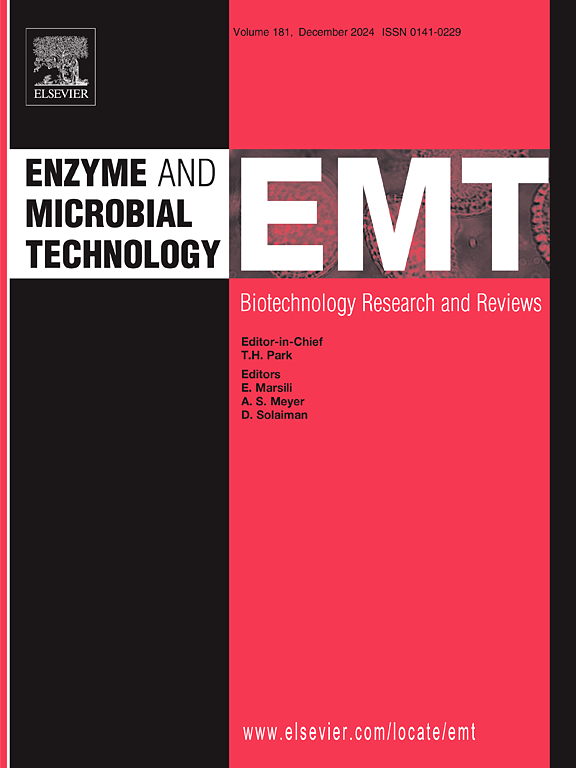Spectrophotometric assay for the screening of selective enzymes towards DHA and EPA ethyl esters hydrolysis
IF 3.4
3区 生物学
Q2 BIOTECHNOLOGY & APPLIED MICROBIOLOGY
引用次数: 0
Abstract
Polyunsaturated fatty acids (PUFAs), such as docosahexaenoic acid (DHA) and eicosapentaenoic acid (EPA), hold notable significance due to their pharmaceutical relevance. Obtaining PUFAs from diverse sources like vegetables, fish oils, and algae poses challenges due to the mixed fatty acid (FA) composition. Therefore, focusing on particular FAs necessitates purification and resolution processes. To address this, we propose a continuous assay for screening lipases selective for ethyl EPA (E-EPA) or ethyl DHA (E-DHA). Utilizing microplate spectrophotometry, the method enables quantification of liberated fatty acids from ethyl esters (E-EPA or E-DHA). This involves assessing enzyme selectivity by measuring the release of FAs through p-nitrophenolate protonation, either separately for each substrate or in competition with a reference substrate, resorufin acetate. Ten lipases underwent screening, revealing Burkholderia cepacia lipase's (BCL) preference for ethyl DHA hydrolysis (E-EPA/E-DHA = 0.82 ± 0.07 and the lipase selectivity ratio (S) for E-EPA/E-DHA = 0.13 ± 0.04) and Candida antarctica lipase B's (CALB) high specific activity towards both E-EPA and E-DHA (531.14 ± 37.76 and 281.79 ± 2.79 U/mg, respectively) and E-EPA preference (E-EPA/E-DHA = 1.86 ± 0.15 and S E-EPA/E-DHA = 2.59±0.15). Candida rugosa recombinant isoform 4 (rCRLip4) and commercial Candida rugosa lipase (CRL) exhibited significant preference for E-EPA hydrolysis (E-EPA/E-DHA = 2.18 ±0.51 and 2.26 ±0.36, respectively; and S E-EPA/E-DHA = 7.59 ± 1.59 and 7.88 ± 2.13, respectively). Docking analyses of rCRLip4, BCL, and CALB demonstrated no statistically significant differences in activation energies or distances to the catalytic serine; however, they agreed with the experimental results. These findings suggest potential mutagenesis or directed evolution strategies for CALB to enhance E-EPA selectivity, with rCRLip4 emerging as a promising candidate for further investigation. This assay offers a valuable tool for identifying lipases with desired substrate selectivity, with broad implications for pharmaceutical and biotechnological applications.
用于筛选 DHA 和 EPA 乙酯水解选择性酶的分光光度测定法
多不饱和脂肪酸(PUFA),如二十二碳六烯酸(DHA)和二十碳五烯酸(EPA),因其与药物的相关性而具有显著的意义。从蔬菜、鱼油和藻类等不同来源获取 PUFAs 会因混合脂肪酸 (FA) 的组成而面临挑战。因此,要专注于特定的脂肪酸,就必须进行纯化和解析过程。为了解决这个问题,我们提出了一种连续测定法,用于筛选对乙基 EPA(E-EPA)或乙基 DHA(E-DHA)具有选择性的脂肪酶。利用微孔板分光光度法,该方法可对从乙酯(E-EPA 或 E-DHA)中释放出的脂肪酸进行定量。这涉及到通过测量对硝基苯酚质子化释放脂肪酸的情况来评估酶的选择性,既可以针对每种底物分别进行,也可以与参考底物醋酸间苯二酚竞争。十种脂肪酶进行了筛选,发现伯克霍尔德氏菌脂肪酶(BCL)偏好水解 DHA 乙酯(E-EPA/E-DHA = 0.82 ± 0.07,E-EPA/E-DHA 的脂肪酶选择性比(S)= 0.13 ± 0.04),而白色念珠菌脂肪酶(BCL)偏好水解 DHA 乙酯(E-EPA/E-DHA = 0.82 ± 0.07,E-EPA/E-DHA 的脂肪酶选择性比(S)= 0.13 ± 0.04)。E-EPA/E-DHA=0.82±0.07,E-EPA/E-DHA 的脂肪酶选择性比率(S)=0.13±0.04),而白色念珠菌脂肪酶 B(CALB)对 E-EPA 和 E-DHA 均具有较高的特异性活性(分别为 531.14±37.76 和 281.79±2.79 U/mg )和 E-EPA 偏好(E-EPA/E-DHA=1.86±0.15,S E-EPA/E-DHA =2.59±0.15)。皱褶念珠菌重组异构体 4(rCRLip4)和商用皱褶念珠菌脂肪酶(CRL)表现出明显的 E-EPA 水解偏好(E-EPA/E-DHA = 2.18 ±0.51 和 2.26 ±0.36;S E-EPA/E-DHA = 7.59 ± 1.59 和 7.88 ± 2.13)。rCRLip4、BCL 和 CALB 的对接分析表明,它们的活化能或与催化丝氨酸的距离在统计学上没有显著差异;不过,它们与实验结果一致。这些发现表明,CALB 有可能采用诱变或定向进化策略来提高 E-EPA 的选择性,而 rCRLip4 则有望成为进一步研究的候选对象。这种检测方法为鉴定具有所需底物选择性的脂肪酶提供了一种有价值的工具,对制药和生物技术应用具有广泛的意义。
本文章由计算机程序翻译,如有差异,请以英文原文为准。
求助全文
约1分钟内获得全文
求助全文
来源期刊

Enzyme and Microbial Technology
生物-生物工程与应用微生物
CiteScore
7.60
自引率
5.90%
发文量
142
审稿时长
38 days
期刊介绍:
Enzyme and Microbial Technology is an international, peer-reviewed journal publishing original research and reviews, of biotechnological significance and novelty, on basic and applied aspects of the science and technology of processes involving the use of enzymes, micro-organisms, animal cells and plant cells.
We especially encourage submissions on:
Biocatalysis and the use of Directed Evolution in Synthetic Biology and Biotechnology
Biotechnological Production of New Bioactive Molecules, Biomaterials, Biopharmaceuticals, and Biofuels
New Imaging Techniques and Biosensors, especially as applicable to Healthcare and Systems Biology
New Biotechnological Approaches in Genomics, Proteomics and Metabolomics
Metabolic Engineering, Biomolecular Engineering and Nanobiotechnology
Manuscripts which report isolation, purification, immobilization or utilization of organisms or enzymes which are already well-described in the literature are not suitable for publication in EMT, unless their primary purpose is to report significant new findings or approaches which are of broad biotechnological importance. Similarly, manuscripts which report optimization studies on well-established processes are inappropriate. EMT does not accept papers dealing with mathematical modeling unless they report significant, new experimental data.
 求助内容:
求助内容: 应助结果提醒方式:
应助结果提醒方式:


